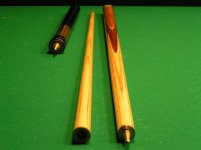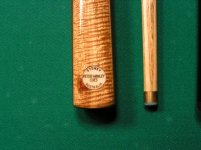You are using an out of date browser. It may not display this or other websites correctly.
You should upgrade or use an alternative browser.
You should upgrade or use an alternative browser.
what is crocheting the ball stroke
- Thread starter bbb
- Start date
in mr bond's rambow thread the email he received says this
The shaft has spliced Ebony on the tip and the butt has a flattened area (for crocheting the ball, legal shot up to 1930)
does anyone know what that is and can explain the stroke??
The flat spot on the butt goes back to billiards’ origins.
It was for sliding the cue along the table to strike the cue ball.
Eventually, the mechanical bridge was thought of....
...and then that hit became a foul.
I’ve never heard it called crocheting, though.
The flat spot on the butt goes back to billiards’ origins.
It was for sliding the cue along the table to strike the cue ball.
Eventually, the mechanical bridge was thought of....
...and then that hit became a foul.
I’ve never heard it called crocheting, though.
How about Croquet :groucho:
The flat spot on the butt goes back to billiards’ origins.
It was for sliding the cue along the table to strike the cue ball.
Eventually, the mechanical bridge was thought of....
...and then that hit became a foul.
I’ve never heard it called crocheting, though.
thanks for the reply...:thumbup:
How about Croquet :groucho:
That makes more sense, since croquet mallets and the mace have the same origin. The flat part of the butt was like the redesign of the mallet end of the mace once hitting with the tail end (the queue end) became the norm.
Freddie <~~~ crochet needles not allowed on planes
Snooker and pool cues over here in the UK still retain the flat part as a throwback to the past, we call it the chamfer.
It does actually still serve a purpose for many players (myself included) who like to hold the cue in the same orientation every time.
It does actually still serve a purpose for many players (myself included) who like to hold the cue in the same orientation every time.
I’ve bought some of those snooker cues over the years....if I liked it...
...I would have a cue maker fill it in....I feel the perfect cue would be round....
....from the end of the butt to the tip.
I’ve bought some of those snooker cues over the years....if I liked it...
...I would have a cue maker fill it in....I feel the perfect cue would be round....
....from the end of the butt to the tip.
This is what I was told by a snooker cue builder in Australia: Since ash is a directional wood (most snooker cues made of ash, at least the shaft) the flat area in the butt is used to index the proper direction for the shaft to be in for consistent play. The ash shaft typically has one side where the grain looks like a series of arrows, that should be the top and align w/the flat area in the butt.
Made sense to me at the time and since he made me a snooker cue that looked just as he described I believe him. If the shaft is maple it shouldn't matter.
Dave
Here's a picture that shows the "arrow" like grain of the top of the shaft (the flat area in butt is at top also). the bottom side is not as nice:
Attachments
What is crocheting the ball stroke?
That's easy. Here is a classic demonstration.
crocheting the ball
.
That's easy. Here is a classic demonstration.
crocheting the ball
.
What is crocheting the ball stroke?
That's easy. Here is a classic demonstration.
crocheting the ball
.
that is croTcheting the ball stroke.......:lmao:
That makes more sense, since croquet mallets and the mace have the same origin. The flat part of the butt was like the redesign of the mallet end of the mace once hitting with the tail end (the queue end) became the norm.
Freddie <~~~ crochet needles not allowed on planes
Snooker and pool cues over here in the UK still retain the flat part as a throwback to the past, we call it the chamfer.
thanks for the replies
i did a search on chamber and snooker cues found a snooker history site that had this to say
During the time of change over from the mace to the cue - the rules of 1779 also indicate that strokes could be made using the point of the cue or providing your adversary agreed you could use the butt of the cue presumably as if it was a mace, and this is accepted as the reason why to this day most English cues still have a chamfer on the butt and indeed very old cues have chamfers on both sides of the butt.
This is what I was told by a snooker cue builder in Australia: Since ash is a directional wood (most snooker cues made of ash, at least the shaft) the flat area in the butt is used to index the proper direction for the shaft to be in for consistent play. The ash shaft typically has one side where the grain looks like a series of arrows, that should be the top and align w/the flat area in the butt.
Made sense to me at the time and since he made me a snooker cue that looked just as he described I believe him. If the shaft is maple it shouldn't matter.
Dave
Here's a picture that shows the "arrow" like grain of the top of the shaft (the flat area in butt is at top also). the bottom side is not as nice:
I was never a fan of ash cues, David...the hit is very close to maple.....
...but it’s an open grain wood...as it gets older, you get hills and valleys.
But the main reason is because of the way it flexes..when the arrows are up or sideways...
...you get two different flexes.
If maple is round and straight...it doesn’t matter...flexes the same.
..and don’t get me started on brass ferrules...sometimes, tradition sucks...:angry:
This is what I was told by a snooker cue builder in Australia: Since ash is a directional wood (most snooker cues made of ash, at least the shaft) the flat area in the butt is used to index the proper direction for the shaft to be in for consistent play. The ash shaft typically has one side where the grain looks like a series of arrows, that should be the top and align w/the flat area in the butt.
Made sense to me at the time and since he made me a snooker cue that looked just as he described I believe him. If the shaft is maple it shouldn't matter.
Dave
Here's a picture that shows the "arrow" like grain of the top of the shaft (the flat area in butt is at top also). the bottom side is not as nice:
thanks for the pics and the reply....:thumbup:
If maple is round and straight...it doesn’t matter...flexes the same.
Some... but not all maple shafts have more flex toward one side.
With the cue butt on a rail, push down on your cue near the joint.
Turn the 180* and push down again, to see if there's a difference.
It may flex more toward one side. The reason for shafts with dots.
.
..and don’t get me started on brass ferrules...sometimes, tradition sucks...:angry:
Snooker tradition and modern understanding of billiard ball collision aside, I assume that like all ferrules (chair leg ferrules, for example), the use of brass in snooker cues just was going with the times where brass provided a high strength-to-weight ratio for any ferrule for any wooden rod that might be subject to splitting.
Freddie <~~~ buck that tradition
I was never a fan of ash cues, David...the hit is very close to maple.....
...but it’s an open grain wood...as it gets older, you get hills and valleys.
But the main reason is because of the way it flexes..when the arrows are up or sideways...
...you get two different flexes.
If maple is round and straight...it doesn’t matter...flexes the same.
..and don’t get me started on brass ferrules...sometimes, tradition sucks...:angry:
I love your replies, Paul! My ash snooker cue is in no danger of getting peaks and valleys, it's mostly a souvenir from my trip to Australia and becoming friends w/Peter Hanley. He made me this cue and I traded him a cue I brought w/me.

